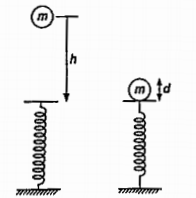The displacement of a particle along the x-axis is given by x=asin2ωt. The motion of the particle corresponds toSolution in Tamil
simple harmonic
on a straight line
on a circle
with constant acceleration
Step by step video & image solution for The displacement of a particle along the x-axis is given by x = asin^2 omegat. The motion of the particle corresponds to by Physics experts to help you in doubts & scoring excellent marks in Class 12 exams.
Topper's Solved these Questions
Similar Questions
A vertical spring with force constant K is fixed on a table. A ball of mass m at a height H above the free upper end of the spring falls vertically on the spring so that the spring is compressed by a dsitance d. The net work done in the process is:
 06:29View Solution
06:29View Solutionlonization potential of hydrogen atom is 13.6 eV. Hydrogen atoms in the ground state are excited by monochromatic radiation of photon energy 12.1 eV. The spectral lines emitted by hydrogen atoms according to Bohr's theory will be
02:24View SolutionThe displacement of a particle along the x- axis it given by x = a sin^(2) omega t The motion of the particle corresponds to
00:58View SolutionThe motion of a particle is given by x=Asinωt+Bcosωt. The motion of the particle is
04:26View SolutionThe displacement of a particle is given by x=cos2ωt. The motion is
04:44View Solutionx-अक्ष पर सरल आवर्त गति करते हुए एक कण का मूलबिंदु से विस्थापन x=Asin(ωt+∂t) द्वारा प्राप्त होता है समय t=0 पर यह कण x=A/2 है और धनात्मक x-दिशा में जा रहा है तब कोण का मान डिग्री मे निकालो ?
01:57View SolutionX - अक्ष के अनुदिश कण का विस्थापन x=asin2ωt द्वारा किया गया है। कण की गति के अनुसार -
01:49View Solutionसरल आवर्त गति करते हुए किसी कण का समीकरण x=Asin(ωt+ϕ) है जहाँ x कण के विस्थापन को प्रदर्शित करता है कण की गतिज ऊर्जा का आवर्तकाल होगा।
03:35View SolutionThe displacement of particle along the X-axis is given by x=asin2ωt. The motion of the particle corresponds to………..
02:23View SolutionThe displacement of a particle along the x-axis is given by x = a sin^2 omega t .The motion of the particle corresponds to
02:23View SolutionThe motion of a particle is given by X=Asinωt+Bcosωt the motion of the particle is
View SolutionThe motion of a particle is given by X=Asinωt+Bcosωt the motion of the particle is
05:26View SolutionThe motion of a particle is given by X=Asinωt+Bcosωt the motion of the particle is
03:12View SolutionThe displacement of a particle along the x-axis is given by x = a sin^(2) omega t . The motion of the particle corresponds to
02:08View SolutionThe displacement of a particle along the x-axis is given by x = a sin^(2) omega t . The motion of the particle corresponds to
03:42View SolutionThe motion of a particle is given by x=Asinωt+Bcosωt. The motion of the particle is
04:44View Solution

